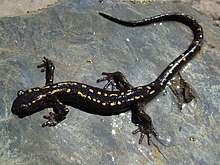Caucasian salamander
The Caucasian salamander (Mertensiella caucasica) is a species of stream-dwelling salamander in the family Salamandridae. This is a salamander of medium size, with a thin, elongated body. It is a relict species, endemic to the south-western Caucasus, in Georgia and Turkey. The subspecies M. c. janashvilii[2] is found at Mt. Mtirala near Batumi and probably along the Black Sea coast.
| Caucasian salamander | |
|---|---|
 | |
| Scientific classification | |
| Kingdom: | Animalia |
| Phylum: | Chordata |
| Class: | Amphibia |
| Order: | Urodela |
| Family: | Salamandridae |
| Subfamily: | Salamandrinae |
| Genus: | Mertensiella Wolterstorff, 1925 |
| Species: | M. caucasica |
| Binomial name | |
| Mertensiella caucasica Waga, 1876 | |
Habitat, behavior and diet
The Caucasian salamander lives along the banks of mountain brooks and small rivers with fast currents, both in the forest belt and above timberline, up to about 2400 m above sea level.[3][4][5][6][7] The species is secretive and strictly nocturnal, and mates on land. The male uses the protuberance on the upper side of the tail for opening the female's cloaca and passes the spermatophore directly to the female.[8][9] Their diets consist of invertebrates living in soil or shallow water; an important part of the diet is amphipods.[10][11]
Reproduction
Sexual dimorphism is expressed by presence of a horn-like protuberance at the upper side of the male's tail, a characteristic recorded only in this species and Luschan's salamander; for this reason, these two species were, for a long time, unified in the same genus, Mertensiella.[12] Mating happens in the summer. the female deposits 10–25 large eggs (0.5 mm in diameter) in hidden places in shallow water or in moist places near brooks.[1][8][9] The larvae hatch in one to two months and hibernate one to three times before metamorphosis.[13]
Evolution
In spite of external similarity with Luschan's salamander (protuberance on the tail), molecular data suggest the closest relative of M. caucasica is the gold-striped salamander (Chioglossa lusitanica) from the north-western Iberian Peninsula.[1][14] Separation from the sister taxon happened about 15 million years ago.[15] A palaeonthological species M. caucasica was found from the lower Pliocene of the Polish Carpathians, the fact suggesting a broader distribution of the species before the Ice Age.[16] Within the current range of the species, two evolutionary lineages are fully separated since the Pliocene: one from the Black Sea Basin, and another from Borjomi Gorge in Central Georgia, in spite of the absence of clear natural boundaries between these two areas.[17]
Threats
The salamander hardly has important natural enemies. The most important factor affecting it is habitat loss, caused by extensive logging in Georgia and construction works in Turkey. Large parts of the habitat of the salamander are not covered by any kind of protected areas.[1][7]
Subspecies
- M. c. caucasica (Waga, 1876)
- M. c. djanaschvilii (Tartarachvili and Bakradze, 1989)
References
- Ugur Kaya, Boris Tuniyev, Natalia Ananjeva, Nikolai Orlov, Theodore Papenfuss, Sergius Kuzmin, David Tarkhnishvili, Sako Tuniyev, Max Sparreboom, Ismail Ugurtas, Steven Anderson (2009) Mertensiella caucasica. In: IUCN 2012. IUCN Red List of Threatened Species. Version 2012.2.
- Tartarashvili, R.V.; Bakradze, M.A. (1989). "New subspecies of the Caucasian salamander". Bull. Acad. Sci. Of Georgia. 133 (1): 177–179.
- Nikolsky, A. M. (1896). "Caucasian salamander (Salamandra caucasica Waga)". Ann. Zool. Mus. Imp. Acad. Sci. 3: 220–223.
- Franzen, M. (1999) Mertensiella caucasica (Waga, 1876) – Kaukasus-Salamander. Handbuch der Reptilien und Amphibien Europas. Band 4/1. Schwanzlurche (Urodela). Grossenbacher, K.G. and Thiesmeier, B. (eds.) 1:329–366. Aula Verlag. Wiesbaden
- Tarkhnishvili, D.N.; Gokhelashvili, R.K. (1999). "The amphibians of the Caucasus". Advances in Amphibian Research in the Former Soviet Union. 4: 1–229.
- Georgia's Biodiversity Database: Mertensiella caucasica. Biodiversity-georgia.net. Retrieved on 2013-01-03.
- Tarkhnishvili D, Kaya U. (2009) Status and Conservation of the Caucasian Salamander (Mertensiella caucasica) Archived 2012-03-01 at the Wayback Machine. pp. 157–165 In: Zazanashvili, N., Mallon, D. (eds), Status and Protection Of Globally Threatened Species In The Caucasus.
- Schultschik, G. (1994). "Zur Fortpflanzungbiologie von Mertensiella caucasica (Waga, 1876) (Urodela: Salamandridae)". Abh. Ber. Naturk. 17: 163–175.
- Tarkhnishvili, D.N.; Serbinova, I.A. (1993). "The ecology of the Caucasian salamander (Mertensiella caucasica Waga) in a local population" (PDF). Asiatic Herpetological Research. 5: 147–165. Archived from the original (PDF) on 2012-05-06. Retrieved 2012-08-02.
- Ekvtimishvili, Z.S. (1948). "Feeding of Caucasian salamander (Mertensiella caucasica Waga)". Proc. Inst. Zool. Of Georgian Acad. Sci. 8: 239–245.
- Kuzmin, SL (1992). "Feeding ecology of the Caucasian Salamander (Mertensiella caucasica), with comments on life history". Asiatic Herpetol. Res. 4: 123–131.
- Wolterstorff, W. (1936). "Beitrage zur Kenntnis des Kaukasussalamanders (Mertensiella caucasica Waga)". Zoologischer Anzeiger. 116 (1–2): 1–13. Archived from the original on 2013-02-21.
- Tarkhnishvili, D. N.; Gokhelashvili, R. K. (1994). "Preliminary data of the age structure of a Mertensiella caucasica population". Mertensiella. 4: 327–334.
- Veith, Michael; Steinfartz, Sebastian (2004). "When non-monophyly results in taxonomic consequences—the case of Mertensiella within the Salamandridae (Amphibia: Urodela)" (PDF). Salamandra. 40: 67–80. Archived from the original (PDF) on 2013-09-21.
- Veith, M.; Steinfartz, S.; Zardoya, R.; Seitz, A. & Meyer, A. (1998). "A molecular phylogeny of 'true' salamanders (family Salamandridae)and the evolution of terrestriality of reproductive modes". J. Zool. Syst. Evol. Res. 36: 7–16. doi:10.1111/j.1439-0469.1998.tb00774.x.
- Borja Sanchiz, F.; Mlynarski, M. (1979). "Pliocene salamandrids (Amphibia, Caudata) from Poland". Acta Zoologica Cracov. 24 (4): 175–188.
- Tarkhnishvili, D.N.; Thorpe, R.S. & Arntzen, J.W. (2000). "Pre-Pleistocene refugia and differentiation between populations of the Caucasian salamander (Mertensiella caucasica)" (PDF). Molecular Phylogenetics and Evolution. 14 (3): 414–422. doi:10.1006/mpev.1999.0718. PMID 10712846.
